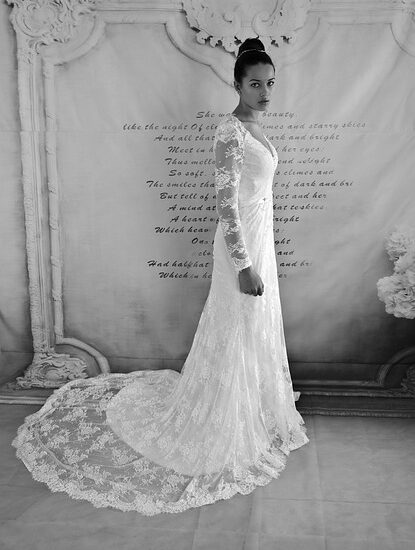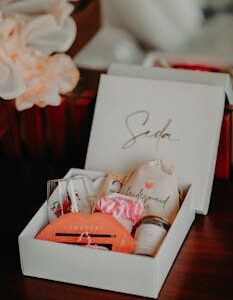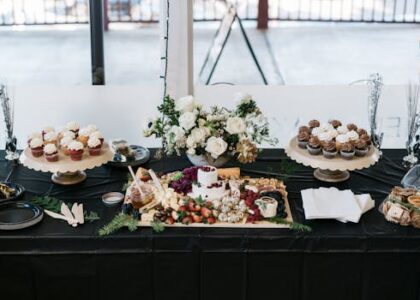Current Trends in Luxury Wedding Veils
Luxury wedding veils are evolving into stunning statements of artistry and personal expression. The current trend emphasizes intricate details and unique fabrics that resonate with high-end couture aesthetics. Satin, silk, and tulle remain popular, but brides are increasingly drawn to ethereal materials like organza or lace, often embellished with delicate embroidery or appliqué work.
Length is a significant factor in today’s veiling choices. Many luxury brides are opting for longer veils that cascade gracefully instead of the traditional shoulder-length options. Floor-length, chapel, or even cathedral veils have surged in popularity, providing a dramatic flourish that amplifies the bridal outfit.
Additionally, color play has become a bold trend. While classic whites and ivories remain timeless, brides are experimenting with soft pastels or even muted hues like blush or champagne for a distinctive touch. Floral and graphic designs are also taking the lead, with veils that feature prints or hand-painted motifs giving a modern twist to the classic.
Statement details like vintage lace trim, crystals, and beading create visual interest, enhancing the bridal look. <Sustainability is becoming increasingly important, with many designers now offering eco-friendly materials and practices. Luxurious yet responsible choices resonate strongly with today’s conscientious brides, making handcrafted veils with ethically sourced materials a sought-after option.
Moreover, customization is at the forefront, as brides seek to personalize their veils, often asking designers to incorporate meaningful elements—be it family heirlooms, specific symbols, or bespoke monograms. These tailored touches not only reflect individuality but also honor tradition, connecting the past with their personal narrative.
The History of Wedding Veils
The wedding veil has a rich and varied history that spans centuries and cultures. Originally, in ancient Rome, brides wore veils called ‘flammeum,’ which were bright orange to symbolize warmth and fertility. This practice was rooted in the belief that the veil would protect the bride from evil spirits and ill-fortune. The veil served as both a protective garment and a way to signify the bride’s transition into marriage.
During the Middle Ages, veils took on a more symbolic meaning, representing modesty and purity. They were often long and flowing, draping over the bride’s face, which allowed for a dramatic entrance. It was during this time that the veil became associated with the Christian notion of chastity, aligning the bride’s look with societal expectations.
By the 19th century, the veil evolved further and became largely decorative. Queen Victoria’s choice of a white wedding dress and lace veil in 1840 set a trend that many brides continue to follow today. This moment marked the shift of veils from simple fabrics to intricate designs adorned with lace and embroidery. The veil became intertwined with the identity of the modern bride, symbolizing elegance and sophistication.
While the veil remains a staple in many wedding ceremonies, its meaning continues to evolve. Contemporary brides can choose from a plethora of styles, lengths, and colors, often reflecting their personal taste rather than tradition. Today’s veils can represent individuality, making each wedding unique. As trends shift, the veil remains a beloved accessory, blending historical significance with modern flair.
Care and Maintenance of Your Wedding Veil
Taking care of your wedding veil can ensure it stays beautiful and pristine long after your big day. Start by gently hanging your veil on a padded hanger to maintain its shape. Avoid folding it, as this can create unwanted creases that are difficult to remove. If your veil is made from delicate fabrics like lace or tulle, consider placing it in a fabric bag to protect it from dust and potential snagging.
Cleaning is crucial. I recommend using a gentle fabric spray to remove any stains immediately after the wedding. If your veil is particularly soiled or has beading, a professional cleaner who specializes in wedding attire is the best bet. Ensure they know the fabric details to prevent damage.
Storage is equally important. Opt for an acid-free box for long-term storage, which will protect it from light and moisture. Place a piece of acid-free tissue paper between layers of the veil to help avoid crushing and maintain its volume.
Before the wedding, make sure to try on your veil with your hairstyle to ensure it complements your look. This way, you can make any last-minute adjustments. Ultimately, regular care and thoughtful storage will keep your veil looking as stunning as it did on your wedding day.
How to Choose the Perfect Veil for Your Dress
The veil you choose can significantly enhance your overall bridal look, so pay close attention to fabric, length, and style. First and foremost, consider the fabric of your dress. If your gown features intricate lace or embellishments, opt for a veil that complements but doesn’t overshadow these details. Tulle and lace are classic choices; however, silk can add a luxurious touch if you seek elegance. The color is equally vital—if your dress is off-white, choose a veil in a similar shade to ensure cohesion.
Next, think about the length of your veil. Shorter veils, like birdcage styles, can create a playful vibe, perfect for casual or vintage weddings. Conversely, chapel or cathedral veils are stunning for formal settings and dramatic entrances. Matching the veil length with your dress’s silhouette helps create a harmonious look. For instance, a fitted gown pairs beautifully with a longer veil, while a ball gown may be complemented by a dramatic, cascading veil.
Don’t ignore the style of your dress. If your gown is modern and sleek, a simple, unadorned veil can add a touch of sophistication without clashing. Conversely, if your dress has vintage elements, a veil with lace trim or detailing can enhance that aesthetic. Additionally, consider other accessories. If you plan to wear a crown or floral headpiece, ensure that the veil complements these items as well.
Finally, don’t forget to try on the veil with your dress. Seeing the complete look is crucial to making a confident choice. Snap some pictures to compare how each option photographs. Above all, choose what feels right for you, as confidence is the best accessory on your big day.
Top Materials Used in Luxury Wedding Veils
Silk is arguably the crème de la crème of veil fabrics. Its natural sheen and smooth texture add a touch of opulence that synthetic materials simply can’t replicate. A silk veil drapes beautifully, creating an ethereal look that complements any wedding dress. Plus, it feels luxurious against the skin, making it a favorite choice among brides who want to feel pampered on their special day.
Tulle is another popular option, especially for those seeking a romantic vibe. This lightweight mesh fabric provides volume and can be layered for added fullness. Tulle veils can range from simple and understated to elaborately embellished. The sheer quality of tulle allows the bridal gown to shine through while still delivering a sense of enchantment.
For brides considering unique styles, lace is a perfect choice. Lace veils exude vintage charm and can feature intricate designs that tie in beautifully with lace wedding gowns. Whether you opt for a full lace veil or lace accents along the edges, this fabric tells a story of tradition and elegance.
Another material to consider is organza, known for its crisp texture. Organza adds structure while still being lightweight and airy. It’s perfect for brides who want a voluminous look without the weight of heavier fabrics.
Lastly, the use of beaded or sequined fabrics is on the rise. These embellished veils catch the light magnificently, adding sparkle and glamour. Perfect for evening weddings or glamorous themes, they make a statement while complementing the bride’s overall look.
As an Amazon Services LLC Associates Program participant, we earn advertising fees by linking to Amazon, at no extra cost to you.
**A stunning luxury veil immediately transforms a bride’s look, adding a layer of sophistication and grace.** It complements the wedding dress beautifully, creating an unforgettable impression on this special day.
The material you choose for your veil can completely transform its appearance. A lightweight tulle offers a soft and romantic vibe, while a satin veil conveys elegance and sophistication. Each fabric brings its unique character, affecting how the veil flows and enhances the overall bridal look.
Veils are evolving; staying current ensures your bridal look feels fresh and stylish. Explore unique styles, fabrics, and embellishments that reflect contemporary trends.
**Your wedding dress should guide your veil choice.** Opt for a veil that complements the style, embellishments, and overall vibe of your gown. **A harmonious look creates stunning visuals.**
Designer veils showcase unique craftsmanship that mass-produced options simply can’t match. The meticulous attention to detail, quality fabrics, and custom designs elevate your bridal look significantly.
Using a protective garment bag and storing it in a cool, dry place can prevent damage. Regularly check for stains and clean it gently to maintain its beauty for future occasions.
As an Amazon Services LLC Associates Program participant, we earn advertising fees by linking to Amazon, at no extra cost to you.

I’m Marta, a passionate wedding specialist with over 25 years of experience in the wedding and party planning business.









